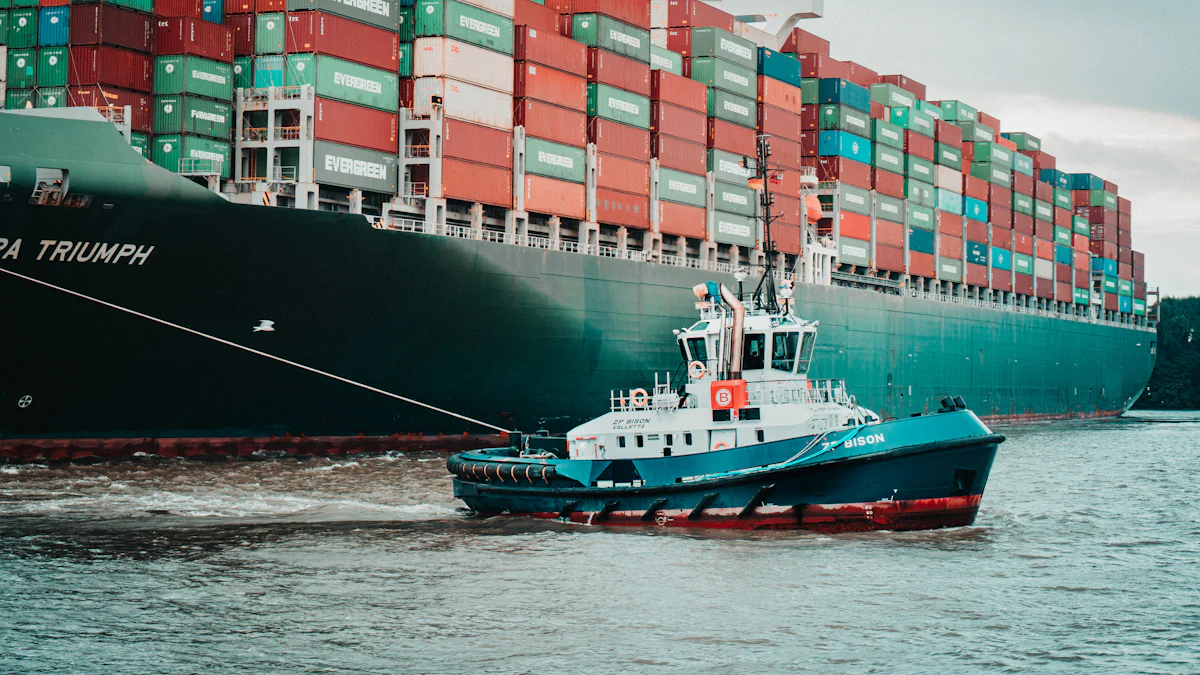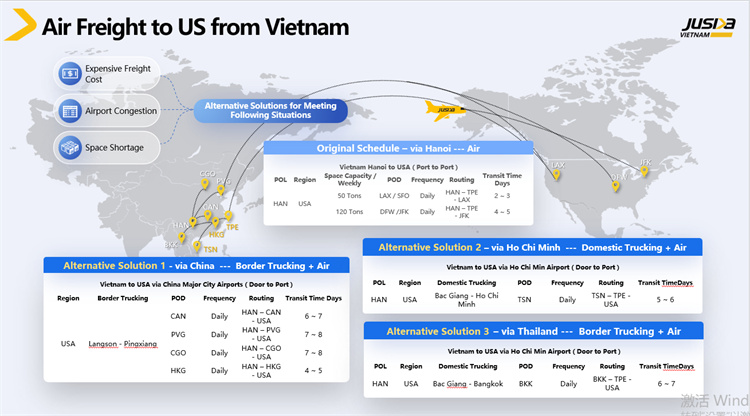Optimizing Logistics Solutions for Manufacturing Companies Shipping From Vietnam to the U.S.

Logistics solutions are crucial in the current economic environment. Vietnam's logistics sector has shown impressive growth, contributing approximately 4.5% to the nation's GDP. The manufacturing companies in Vietnam account for 25% of the GDP, establishing the country as a leader in cost-effective manufacturing. With its strategic location along the North-South axis and extensive borders with China, Laos, and Cambodia, Vietnam offers significant advantages. The country also features a strong infrastructure system, including seaports and airports, which facilitates efficient shipping. These elements make Vietnam an appealing hub for manufacturing companies looking for optimized logistics solutions.
The Development of Viet Nam Manufacturing Industry

Current State of Manufacturing in Vietnam
Vietnam's manufacturing industry has become a pivotal force in the global market. The sector contributes significantly to the nation's GDP, accounting for 25% in 2021. This growth positions Vietnam as a leader in low-cost manufacturing. The country offers competitive advantages due to its strategic location and robust infrastructure. These factors attract numerous manufacturing companies seeking efficient logistics solutions.
Vietnam's textile exports have seen substantial growth. The country competes strongly with other leading textile exporters in the region. The share of textile exports against total exports has increased, making Vietnam a key player in inheriting low value-added textiles from China. This shift underscores the country's potential to dominate the manufacturing landscape.
Current Status of Manufacturing Exports from Vietnam to the United States
Manufacturing exports from Vietnam to the United States have experienced remarkable expansion. The U.S. remains one of Vietnam's largest export markets. Manufacturing companies in Vietnam benefit from favorable trade agreements and competitive production costs. These elements enhance the appeal of Vietnamese products in the American market.
The logistics sector supports this export growth by providing tailored solutions. Vietnam's location on the maritime transport axis offers favorable conditions for international marine freight transport. The country's extensive road transport infrastructure and expanding logistics centers further facilitate efficient shipping processes. Customs clearance procedures have also improved, streamlining the export process to the U.S.
Manufacturing companies capitalize on these advantages to optimize their logistics strategies. The integration of advanced technologies and sustainable practices enhances efficiency. These efforts ensure that Vietnam remains a dominant force in manufacturing exports to the United States.
Challenges in Vietnam's Logistics Sector
Infrastructure Issues
Current State of Infrastructure
Vietnam's logistics infrastructure faces significant challenges. The country has a strategic location along the North-South axis, with extensive borders and access to the East Sea. However, the current infrastructure struggles to meet the demands of rapid economic growth. Roads, seaports, and airports require upgrades to handle increasing volumes of goods. The existing systems often experience congestion and delays, impacting logistics efficiency.
The development of green logistics in Vietnam highlights the importance of infrastructure. Studies emphasize that infrastructure plays a crucial role in promoting sustainable logistics practices. The current state of infrastructure limits the potential for green logistics development. Investment in infrastructure is essential to support logistics activities and enhance efficiency.
Proposed Solutions
To address infrastructure challenges, Vietnam must invest in sustainable development. The government should prioritize upgrading roads, seaports, and airports. These improvements will reduce congestion and improve logistics efficiency. Developing logistics centers can also promote growth and streamline operations.
Infrastructure development should focus on green logistics. Sustainable practices will enhance Vietnam's competitiveness in the logistics sector. Investing in infrastructure will create a foundation for efficient and environmentally friendly logistics solutions.
Labor Shortages
Impact on Logistics
Labor shortages present another challenge for Vietnam's logistics sector. The rapid growth of manufacturing and e-commerce increases demand for skilled workers. However, the supply of qualified labor remains insufficient. This shortage affects logistics operations, leading to delays and inefficiencies.

The lack of skilled labor impacts various aspects of logistics. Companies struggle to find workers for transportation, warehousing, and customs clearance. The shortage of labor affects the overall productivity of logistics operations.
Strategies to Mitigate
To mitigate labor shortages, Vietnam must implement strategic solutions. Training programs can help develop a skilled workforce. These programs should focus on logistics-specific skills, such as transportation management and customs procedures.
Partnerships with educational institutions can support workforce development. Collaborations will ensure that training programs align with industry needs. Companies can also offer incentives to attract and retain skilled workers. Competitive salaries and benefits will make logistics careers more appealing.
Addressing labor shortages requires a comprehensive approach. By investing in workforce development, Vietnam can enhance logistics efficiency and support economic growth.
Exploring Shipping Modes

Express Shipping
Costs and Delivery Times
Express shipping offers the fastest delivery option for goods transported from Vietnam to the U.S. This mode of shipping typically takes between 1 to 4 days, depending on the specific route and logistics provider. The speed of express shipping comes with higher costs compared to other modes. Factors influencing these costs include the weight and dimensions of the shipment, as well as any additional services required. Companies often choose express shipping for high-value or time-sensitive products that require quick delivery.
Suitability for Urgent Shipments
Express shipping is ideal for urgent shipments that demand immediate attention. Businesses often rely on this mode when facing tight deadlines or when the shipment involves perishable goods. The reliability of express shipping ensures that products reach their destination promptly, minimizing potential disruptions in supply chains. Many logistics providers offer tracking services for express shipments, allowing companies to monitor the progress of their goods in real-time.
Sea Freight
Cost-Effectiveness
Sea freight represents a cost-effective shipping solution for companies transporting large volumes of goods from Vietnam to the U.S. This mode of shipping is particularly suitable for non-urgent shipments where delivery time is not a primary concern. Sea freight offers various options, including full container load (FCL) and less than container load (LCL), providing flexibility based on the size and nature of the shipment. The cost-effectiveness of sea freight makes it an attractive option for businesses looking to optimize logistics expenses.

Delivery Time Considerations
The delivery time for sea freight from Vietnam to the U.S. ranges from 30 to 45 days, depending on the destination port and specific shipping routes. Factors such as customs clearance and port congestion can influence transit times. Companies must plan accordingly to accommodate these variables. Despite the longer delivery times, sea freight remains a popular choice due to its affordability and capacity to handle large shipments.
Air Freight to US from Vietnam
Time Saving
Air freight provides a balance between speed and cost for shipments from Vietnam to the U.S. This mode of shipping typically takes around 5 to 10 days, offering a faster alternative to sea freight while being more economical than express shipping. Air freight is suitable for medium-sized shipments that require quicker delivery than sea freight can offer. The time-saving aspect of air freight makes it an appealing option for businesses needing timely delivery without incurring the high costs of express shipping.
Alternative Solutions from JUSDA
JUSDA offers tailored logistics solutions that enhance the efficiency of air freight services. These solutions include optimized routing and consolidation services, which help reduce transit times and costs. JUSDA's expertise in logistics allows companies to benefit from streamlined processes and improved supply chain management. By leveraging JUSDA's alternative solutions, businesses can achieve a competitive edge in their logistics operations.

Customs must-haves
The Documents Required
Customs procedures demand specific documentation for goods exported from Vietnam to the U.S. Companies need to prepare a comprehensive dossier for customs authorities. Essential documents include the commercial invoice, which details the transaction between buyer and seller. The packing list provides information about the contents of each package. The bill of lading serves as a receipt for the shipment and outlines the terms of transport. A certificate of origin verifies the country where the goods were manufactured. Businesses must also submit a business registration certificate to confirm their legal status.
Proper documentation ensures compliance with customs regulations. Customs duties must be paid before goods are released into the U.S. market. Accurate paperwork prevents delays and facilitates smooth customs clearance. Companies should maintain meticulous records to avoid potential issues during the shipping process.
The Operating Steps
The customs clearance process involves several key steps. First, companies must gather all required documents. Accurate and complete documentation is crucial for successful clearance. Next, businesses submit the documents to customs authorities for review. Customs officials inspect the shipment to verify compliance with regulations. This inspection checks the quality, specifications, quantity, and volume of the goods.
After inspection, customs authorities calculate the applicable duties and taxes. Companies must pay these fees before the goods can proceed. Once payment is confirmed, customs officials release the shipment for delivery. Efficient customs procedures minimize delays and ensure timely delivery of goods. Businesses should familiarize themselves with these steps to optimize their logistics operations.
Tailored Logistics Solutions
JUSDA's Offerings
Customized Shipping Solutions
JUSDA provides a range of customized shipping solutions tailored to meet the unique needs of manufacturing companies in Vietnam. The logistics services offered by JUSDA focus on optimizing efficiency and reducing costs for businesses shipping goods to the U.S. JUSDA leverages advanced technology and strategic partnerships to offer seamless logistics solutions. Companies benefit from JUSDA's expertise in managing complex supply chains and navigating international shipping regulations.

JUSDA
Supply Chain Management Solution
JUSDA's customized shipping solutions include optimized routing and consolidation services. These services help reduce transit times and minimize logistics expenses. The company offers flexible shipping options, including express, air, and sea freight, to accommodate various business requirements. JUSDA's commitment to innovation ensures that clients receive the most efficient and cost-effective logistics solutions available.
JUSDA’s Service
JUSDA Vietnam boasts over 15 years of experience in the logistics industry, offering comprehensive services tailored to meet the needs of clients exporting from Vietnam. The company prides itself on its self-owned customs team, ensuring smooth and efficient clearance processes. With multilingual capabilities in Chinese, English, and Vietnamese, JUSDA Vietnam facilitates seamless communication across diverse client bases. Specializing in the handling of both new and used equipment, as well as sensitive materials such as electronics, automobiles, and semiconductor raw materials, the company provides tailored solutions for various industries. Notably, JUSDA Vietnam offers the shortest cargo handover times, thanks to its off-terminal operations, ensuring quick and reliable delivery. The close relationship with customs authorities further enhances the company's ability to deliver exceptional service, making it a trusted partner for businesses looking to streamline their logistics operations.
Vietnam's logistics industry is experiencing significant growth due to the expansion of the e-commerce sector. The country offers great potential for developing logistics services across land, sea, and air. Manufacturing companies should consider tailored logistics solutions to enhance efficiency. Specialized logistics services can meet customer demands in the growing e-commerce market. Improving shipping processes to the U.S. will provide a competitive edge. Vietnam's strategic location and infrastructure advancements position it as a key player in international logistics.
See Also
Efficiently Navigating High-Tech Manufacturing Logistics for Success
Optimizing High-Tech Manufacturing Supply Chain Solutions
Revealing Insider Tips for Efficient Supply Chain Logistics
